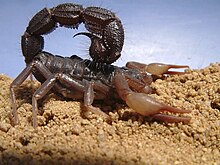Bestoxin
| The amino acid sequence of Bestoxin | |
|---|---|
| N - Ala - Asp - Val - Pro - Gly - Asn - Tyr - Pro - Leu - Asp - Lys - Asp - Gly - Asn - Thr - Tyr - Thr - Cys - Leu - Glu - Leu - Gly - Glu - Asn - Lys - Asp - Cys - Gln - Lys - Val - Cys - Lys - Leu - His - Gly - Val - Gln - Tyr - Gly - Tyr - Cys - Tyr - Ala - Phe - Ser - Cys - Trp - Cys - Lys - Glu - Tyr - Leu - Asp - Asp - Lys - Asp - Ser - Val - OH |
Bestoxin is a neurotoxin from the venom of the South African spitting (or fattail) scorpion Parabuthus transvaalicus. Most likely, it targets sodium channel function, thus promoting spontaneous and repetitive neuronal firing. Following injection into mice, it causes non-lethal writhing behaviour.
Sources

Bestoxin is one of the many components that can be isolated from the venom of the South African spitting scorpion. Other peptide toxins also found in the venom include dortoxin, birtoxin, and altitoxin.[1] Together with birtoxin, dorotoxin, altitoxin and ikitoxin, this mammal-specific ion channel toxin is a member of the birtoxin polypeptide family. These birtoxin-like polypeptides contribute significantly to the venom's toxicity, since they constitute at least 30% of the peptides in the venom of this scorpion.[2]
Chemistry
Although the birtoxin-like polypeptides, including bestoxin, are 58 amino acids long and have only three disulfide bridges, they resemble long chain neurotoxins, which typically have a length of 60–70 amino acids and four disulfide bridges.[1] Bestoxin, as most of the known scorpion toxins, has α-helixes that are lined up with basic amino acid residues. Furthermore, bestoxin has localized positively and negatively charged surfaces, a unique property of the birtoxin polypeptide family.[2]
Target & mode of action
Based on its resemblance to long chain β-neurotoxins, bestoxin most likely binds to neurotoxin receptor site 4 of the sodium channel. Binding of long chain β-neurotoxins is voltage-independent, and results in a shift of the voltage-activation curve towards more negative potentials, inducing abnormal sodium channel permeability and promoting spontaneous and repetitive firing.[3][4][5]
Toxicity
Mice injected with bestoxin show intense writhing. This abnormal behavior is characterized by twisting of the neck, followed by the body, and making a full turn around the body axis. The intensity of this behavior increases over time and the mice start to spin around. After approximately 24 hours the amount of writhing decreases and the twisting behavior gradually slows down to one turn per two seconds. Furthermore, there is no lethality observed. The dosage that produces a desired effect in 99% of the test population, or ED99, of bestoxin is 100 ng of peptide per 20 g mouse bodyweight.[1] No data is available on the effect of bestoxin in humans or primates.
Treatment
Bestoxin is one of the many neurotoxic peptidic components in the venom of the South African spitting scorpion. The birtoxin-like peptides share an N-terminus of eighteen amino acid residues. Neutralization of this domain results in a decrease of toxicity of the venom.[6] Mass spectrometry and western blotting confirmed that these neurotoxins react with polyclonal antibodies and it is proposed that polyclonal antibodies will neutralize the N-terminus domain and finally the venom in a dose dependent manner. Moreover, previous work has proven that this polyclonal antibody approach is an effective strategy for antivenom production.[6]
References
- ^ a b c Inceoglu, B; J Lango; I Pessah; B Hammock (2005). "Three structurally related, highly potent, peptides from the venom of possess divergent biological activity". Toxicon. 45 (6): 727–733. doi:10.1016/j.toxicon.2005.01.020. ISSN 0041-0101. PMID 15804521.
- ^ a b Zeng, Xian-Chun; Luo, Feng; Wen-Xin, Li (2006). "Molecular dissection of venom from Chinese scorpion Mesobuthus martensii: Identification and Characterization of four novel disulfide-bridged venom peptides". Peptides. 27 (7): 1745–1754. doi:10.1016/j.peptides.2006.01.012. PMID 16513212. S2CID 12636773.
- ^ Possani, Lourival; Merino, Enrique; Corona, Miguel; Bolivar, Francisco; Becerril, Baltazar (2000). "Peptides and genes coding for scorpion toxins that affect ion-channels". Biochimie. 82 (9–10): 861–868. doi:10.1016/S0300-9084(00)01167-6. PMID 11086216.
- ^ Couraud, F; Jover, E; Dubois, J.M; Rochat, H (1982). "Two types of scorpion toxin receptor sites, one related to the activation, the other to the inactivation of the action potential sodium channel". Toxicon. 20 (1): 9–16. Bibcode:1982Txcn...20....9C. doi:10.1016/0041-0101(82)90138-6. PMID 6281941.
- ^ https://www.uniprot.org/uniprot/P0C1B6 - Bestoxin - Parabuthus transvaalicus (South African fattail scorpion)
- ^ a b Inceoglu, Bora; Lango, Jozsef; Rabinovich, Alina; Whetstone, Paul; Hammock, Bruce D. (2006). "The neutralizing effect of a polyclonal antibody raised against the N-terminal eighteen-aminoacid residues of birtoxin towards the whole venom of Parabuthus transvaalicus". Toxicon. 47 (2): 144–149. Bibcode:2006Txcn...47..144I. doi:10.1016/j.toxicon.2005.08.018. PMID 16356521.
